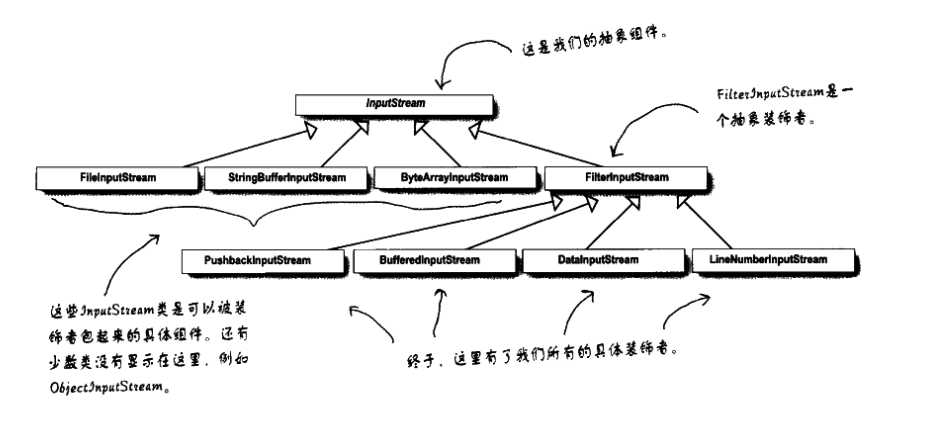标签:
装饰模式的定义:
动态地将责任附加到对象向,若要扩展功能,装饰模式提供了比继承更有弹性的替代方案。
遵循的设计原则是开闭原则,也是对扩展开放,对修改关闭。

/** *定义被装饰者 * */ public interface Human { public void wearClothers(); public void walkToWhere(); } /** * 定义抽象装饰者 * */ public abstract class Decorate implements Human { Human human; public Decorate(Human human) { this.human = human; } public void wearClothers() { this.human.wearClothers(); } public void walkToWhere() { this.human.walkToWhere(); } } /** * *装饰者 zero */ public class DecorateZero extends Decorate{ public DecorateZero(Human human) { super(human); } @Override public void walkToWhere() { super.walkToWhere(); System.out.println("Zero.............walkToWhere"); } @Override public void wearClothers() { super.wearClothers(); System.out.println("Zero.............wearClothers"); } } /** * 装饰者two * */ public class DecorateTwo extends Decorate{ public DecorateTwo(Human human) { super(human); } @Override public void walkToWhere() { super.walkToWhere(); System.out.println("Two.............walkToWhere"); } @Override public void wearClothers() { super.wearClothers(); System.out.println("Two.............wearClothers"); } } // public class DecorateFirst extends Decorate{ public DecorateFirst(Human human) { super(human); } @Override public void walkToWhere() { super.walkToWhere(); System.out.println("First.............walkToWhere"); } @Override public void wearClothers() { super.wearClothers(); System.out.println("First.............wearClothers"); } } /** * *测试代码 */ public class Test { public static void main(String[] args) { DecorateZero zero=new DecorateZero(new DecorateFirst(new DecorateTwo(new Human() { //这里装饰者原有的行为,这里我没有具体去写实现类。 @Override public void wearClothers() { // TODO Auto-generated method stub System.out.println("1111111wearClothers1111111"); } @Override public void walkToWhere() { // TODO Auto-generated method stub System.out.println("1111111walkToWhere1111111"); } }))); zero.walkToWhere(); System.out.println("*******************************************"); zero.wearClothers(); } } //测试结果 1111111walkToWhere1111111 Two.............walkToWhere First.............walkToWhere Zero.............walkToWhere ******************************************* 1111111wearClothers1111111 Two.............wearClothers First.............wearClothers Zero.............wearClothers
关键点:
1、Decorator抽象类中,持有Human接口,方法全部委托给该接口调用,目的是交给该接口的实现类即子类进行调用。
2、Decorator抽象类的子类(具体装饰者),里面都有一个构造方法调用super(human),这一句就体现了抽象类依赖于子类实现即抽象依赖于实现的原则。因为构造里面参数都是Human接口,只要是该Human的实现类都可以传递进去,即表现出Decorator dt = new Decorator_second(new Decorator_first(new
Decorator_zero(human)));这种结构的样子。所以当调用dt.wearClothes();dt.walkToWhere()的时候,又因为每个具体装饰者类中,都先调用super.wearClothes和super.walkToWhere()方法,而该super已经由构造传递并指向了具体的某一个装饰者类(这个可以根据需要调换顺序),那么调用的即为装饰类的方法,然后才调用自身的装饰方法,即表现出一种装饰、链式的类似于过滤的行为。
3、具体被装饰者类,可以定义初始的状态或者初始的自己的装饰,后面的装饰行为都在此基础上一步一步进行点缀、装饰。
4、装饰者模式的设计原则为:对扩展开放、对修改关闭,这句话体现在我如果想扩展被装饰者类的行为,无须修改装饰者抽象类,只需继承装饰者抽象类,实现额外的一些装饰或者叫行为即可对被装饰者进行包装。
java.io包内的类太多了,简只是……”排山倒海“,其实是因为里面许多类都是装饰者,其实java.io也引出装饰者模式的一个缺点:利用装饰着模式,常常设计中有大量的小类,数量实在太多,造成使用者非常大的困扰。了解装饰者模式的原理看起就会简单多了。

功能:把输入的大写字母写成小写
例如:This is LONGHAIBO,使用此装饰者变成this is longhaibo
public class TestDecorate { public static void main(String[] args) { int c; try (InputStream in = new LowerCaseIputStream(new BufferedInputStream( new FileInputStream("src/decorate.txt")))) { while ((c=in.read())>0) { System.out.print((char)c); } } catch (Exception e) { // TODO: handle exception e.printStackTrace(); } } } /** * Java io 装饰者模式 * 功能:把输入的大写字母写成小写 * 例如:This is LONGHAIBO,使用此装饰者变成this is longhaibo * */ class LowerCaseIputStream extends FilterInputStream { protected LowerCaseIputStream(InputStream in) { super(in); } //针对字节 @Override public int read() throws IOException { int c=super.read(); return (c==-1?c:Character.toLowerCase((char)c)); } //针对字节数组 @Override public int read(byte[] b, int off, int len) throws IOException { int result=super.read(b, off, len); for (int i = off; i < off+result; i++) { b[i]=(byte)Character.toLowerCase((char)b[i]); } return result; } }
this is longhaibo
参考资料
head_first设计模式(中文版)
http://blog.csdn.net/jason0539/article/details/22713711
标签:
原文地址:http://www.cnblogs.com/demacian/p/4514744.html